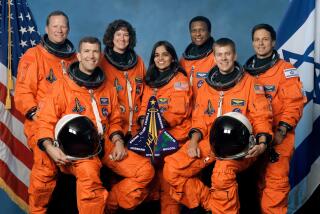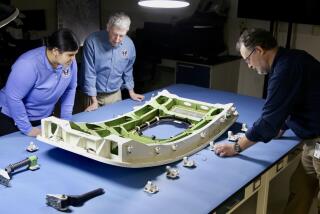A Ton of Force May Have Struck Shuttle’s Wing, Tests Show
CAPE CANAVERAL, Fla. — The Columbia accident investigator in charge of a series of impact tests said Wednesday that he is surprised by the incredible force with which a 1 1/2-pound chunk of space shuttle foam struck and deformed a fiberglass wing replica.
NASA’s Scott Hubbard said he expects even more damage when real shuttle wing parts -- weaker and more brittle than fiberglass -- are used for the next round of testing, beginning today. He expects the wing pieces, removed from the shuttle Discovery, to actually break.
“This moves us a lot closer to saying that the foam can do this kind of damage,” said Hubbard, a member of the Columbia Accident Investigation Board.
The board suspects a similarly sized piece of fuel-tank foam insulation knocked the hole in the leading edge of Columbia’s left wing that, two weeks later, let in scorching atmospheric gases and doomed the shuttle and its seven astronauts during reentry.
In last week’s test at the Southwest Research Institute in San Antonio, a piece of foam nearly 20 inches long was fired through a giant nitrogen-pressurized gun at more than 530 mph at a mock-up of the wing’s leading edge. The fiberglass panels and seals were from the shuttle prototype Enterprise, which never flew in space.
The foam deflected the panel that was the bull’s-eye and shoved and lifted an adjoining seal, Hubbard said. The foam shattered, and pieces of it crammed into the nearly half-inch gap created by the dislodged seal. The crevice -- about 22 inches long -- held its shape because of the foam stuffing.
“People’s intuitive sense of physics is sometimes way off. You don’t feel that this [foam] can do anything,” Hubbard said. “But you fire this at 500 mph and there you saw it. I really did think, ‘Oh my God, this is really an impact. This is a significant effect.’ ... That’s when it came home to me, what it really means.” The stress recorded in the May 29 test was up to seven times higher than expected and rippled across the panels, Hubbard said. But that peak force lasted just one-half of one-thousandth of a second, not long enough to break fiberglass, he noted.
It equated to a ton of force, all compressed into 60 or 70 square inches of fiberglass panels, Hubbard said. According to predictions, that is perhaps 70% more force than needed to break real leading-edge pieces, which are made of reinforced carbon.
At the Kennedy Space Center, meanwhile, the chairman of the Columbia reconstruction team gave a final news media tour of the 85,000 pounds of wreckage.
Mike Leinbach, who normally works as launch director, said the wreckage points to the breach as having occurred probably somewhere around the bottom of carbon panel No. 8 of the left wing’s leading edge. The initial hole could have been in the panel itself or an adjoining seal; there is not enough evidence to know for sure, he said. “The key here is how much is not here, versus how much is over on the right-hand side,” Leinbach said, pointing to what little is left of the left wing. “Columbia held in there. She hung in there for a long, long time,” he said.
More to Read
Sign up for Essential California
The most important California stories and recommendations in your inbox every morning.
You may occasionally receive promotional content from the Los Angeles Times.










